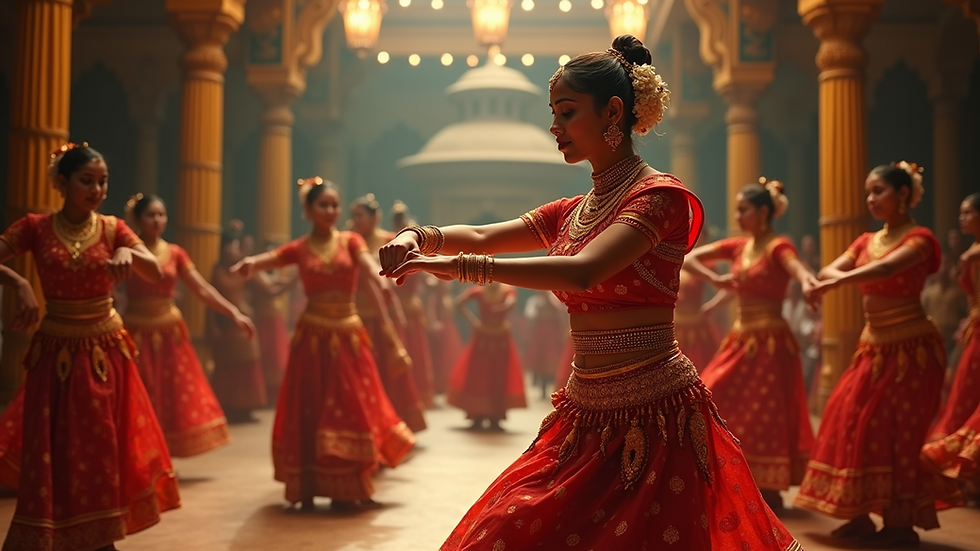The Beauty and History of Kathak Dance
- Festive India Ltd
- Sep 22
- 4 min read
When I first encountered the mesmerizing movements of Kathak, I was instantly captivated by its grace and storytelling power. This traditional Indian dance form is not just a performance; it is a living narrative that connects us to centuries of culture and history. Today, I want to take you on a journey through the beauty and history of Kathak dance, sharing insights that will deepen your appreciation for this exquisite art.
Exploring the Roots of a Traditional Indian Dance Form
Kathak is one of the eight classical dance forms of India, with origins tracing back over a thousand years. It began as a storytelling art performed by traveling bards called "Kathakars," who narrated mythological tales through expressive gestures, intricate footwork, and rhythmic spins. The word "Kathak" itself comes from the Sanskrit word "katha," meaning story.
Over time, Kathak evolved under the influence of various cultural and religious traditions. It flourished in the temples of North India, where dancers depicted stories from Hindu epics like the Ramayana and Mahabharata. Later, during the Mughal era, Kathak absorbed Persian and Central Asian elements, adding a royal elegance and refined technique to its repertoire.
This blend of spiritual storytelling and courtly sophistication makes Kathak a unique dance form that bridges diverse cultural worlds. Its evolution reflects the rich tapestry of Indian history and the adaptability of its artistic traditions.

The Elements That Define This Traditional Indian Dance Form
What makes Kathak so distinctive? Several key elements come together to create its enchanting effect:
Footwork (Tatkar): The rhythmic stamping of the feet is central to Kathak. Dancers wear small bells called "ghungroos" that accentuate every step, creating a captivating soundscape.
Spins (Chakkars): Rapid, controlled spins are a hallmark of Kathak, symbolising the dancer’s mastery over balance and rhythm.
Expressive Gestures (Mudras): Hand gestures and facial expressions convey emotions and narrate stories, making the dance deeply communicative.
Costume and Makeup: Traditional attire includes flowing skirts for women and elegant kurtas for men, often adorned with intricate embroidery and jewellery.
Music and Rhythm: Kathak is performed to classical Hindustani music, with tabla and harmonium providing the rhythmic and melodic foundation.
Each performance is a blend of technical skill and emotional expression. The dancer invites the audience into a world where every movement tells a story, every beat resonates with history.

What is the significance of Kathak dance?
Kathak is more than just an art form; it holds deep cultural and spiritual significance. Historically, it served as a medium to preserve and transmit stories from ancient scriptures and folklore. Through dance, complex narratives about gods, heroes, and moral lessons were made accessible to all, regardless of literacy.
In the Mughal courts, Kathak became a symbol of cultural synthesis, blending Hindu and Muslim artistic traditions. This fusion enriched the dance, making it a celebration of India's pluralistic heritage.
Today, Kathak continues to be a powerful tool for cultural expression and identity. It connects people to their roots and fosters a sense of community. For many, learning and performing Kathak is a way to honour their ancestors and keep traditions alive.
Moreover, Kathak encourages discipline, creativity, and emotional intelligence. It teaches patience through rigorous practice and empathy through storytelling. Whether performed on grand stages or in intimate gatherings, Kathak remains a vibrant thread in the fabric of Indian culture.

How to Experience and Learn Kathak Dance
If you feel inspired to explore Kathak yourself, there are many ways to begin your journey:
Find a Local Dance School: Look for instructors who specialise in classical Indian dance. Many communities offer classes for beginners and advanced students alike.
Attend Performances: Watching live Kathak shows can deepen your understanding and appreciation. Festivals and cultural events often feature talented dancers.
Online Resources: There are excellent tutorials and documentaries available online that introduce the basics of Kathak.
Practice Regularly: Like any art, Kathak requires dedication. Start with simple footwork and hand gestures, gradually building your skills.
Immerse in the Culture: Learn about the music, costumes, and stories behind the dance. This context enriches your practice and performance.
For those in Sheffield and beyond, places like Festive India Ltd offer not only traditional products but also cultural events where you can experience Kathak and other Indian art forms firsthand. Engaging with such communities can be both inspiring and rewarding.
Celebrating Indian Culture Through Kathak and More
Kathak dance is a beautiful gateway into the rich heritage of India. It invites us to celebrate history, spirituality, and artistic excellence all at once. Whether you are a dancer, a spectator, or simply curious, embracing Kathak can open new doors to understanding and joy.
If you want to explore more about this captivating art, consider visiting Festive India Ltd, your go-to place in Sheffield for celebrating Indian culture. They offer a wide range of traditional products and host vibrant cultural events that bring communities together.
By supporting such initiatives, we help preserve and promote the timeless beauty of Kathak and other traditional Indian dance forms. So why not take a step today? Dive into the rhythm, the stories, and the magic of Kathak dance - you might just discover a new passion.
I hope this glimpse into Kathak has inspired you to explore this traditional Indian dance form further. Its history, significance, and artistry offer something truly special for everyone interested in Indian culture and heritage.



Comments